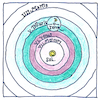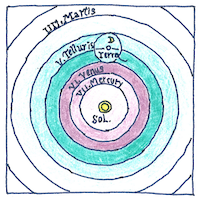Nicolaus Copernicus
astronomy

|
Heliocentrism
As Nicolaus Copernicus said in his book On the Revolutions of the Celestial Spheres, moons and planets orbit more than one center. Only the moon orbits the earth. The celestial spheres orbit the sun. The firmament moves because the earth turns. The seasons change because the earth wobbles as it orbits the sun. Planets sometimes appear to move backward only because the earth moves. Earth’s distance to the sun is insignificant compared to the sun’s distance to the stars.
Consistency
Copernicus changed the center of the universe but otherwise retained Ptolemaic errors. His celestial objects sit in crystalline spheres. His orbits are circular or compounded of multiple circles. His planets move at a uniform speeds. Copernicus defended his system because it was geometrically simpler.
Without a center
We may not have our planet as the stationary center of an eternal universe. Nor may we have our sun as such. Our solar system is only part of a Milky Way galaxy in flux, and ours is only one of many galaxies drifting without a center. William Herschel thought the craters of the moon were circular cities for a lunar race, and ours was only one of many peopled worlds in which, like ours, I say, every adult must act as if he or she made his or her own decisions according to his or her own sense of what is right.



Copernicus was not the first person to propose a heliocentric universe; however, Copernicus provided a predictive mathematical model.
Copernicus placed the center of the universe near but not at the sun. Understanding how gravity controls the orbits of planets and moons escaped him, as well as Kepler and Galileo.
Andreas Osiander wrote an preface for the first edition of De revolutionibus orbium coelestium that stated that the Copernican theory was not intended as a description of the literal truth but only as a simpler mathematical description of astronomical observations to improve the calendar.
See also in The book of science:
Readings in wikipedia: